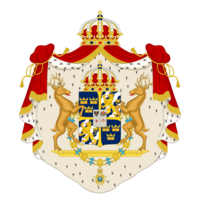House of Eirikr
| House of Eirikr Hus av Eirikr House of Kveldling House of Hrudolfung | |
|---|---|
| Royal house | |
 | |
| Country | Emerstari |
| Current region | Scania |
| Etymology | from Erik I |
| Place of origin | Kingdom of Flodland |
| Founded | December 25, 726 |
| Founder | Erik I of Emerstari |
| Current head | Erik XII Georg of Emerstari |
| Titles | |
| Members | Ailigean III Erik XII Georg James VI Kjoste II Aadolf Willem IX |
| Connected families | House of Leijonhuvud House of Potois |
| Traditions | Lutheranism |
| Motto | God, Åra, Rett (God, Honor, and Right) |
| Estate(s) | Midtenflodplats |
| Cadet branches | |
The House of Eirikr (Emerstarian: Hus av Eirikr) is an Emerstarian dynasty which has more or less continuously held the throne of the Kingdom of Emerstari since its creation in 1047. Dynastic marriages, especially of the children of the "Grandfather of Scania" Erik VIII Olaf, led the family to expand its domains throughout the Scanian peninsula. Due to the consolidation of Scania in the nineteenth century, however, members of the House of Eirikr and its cadet branches reign in only six countries today: Canaria, Eilben, Emerstari, Ingelland, New Retermi, and Soumeland.
As a result of cognatic lines and legitimized bastards, there are several cadet branches of the House of Eirikr, some of which are either extinct completely or have no surviving agnatic lines, such as the House of Håkonung, the House of Margretning, and the House of Ljungeting. Cadet branches which still have direct male lines descending from Eirikr, and thus Kveldur, include the House of Ergoisme, the House of Eirikr–Kóhenny whose members currently reign in Eilben, the House of Malmø whose members reigned in Emerstari from 1250 to 1270 and again from 1303 to 1370, the House of Mounsing whose members currently reign in Ingelland, the House of Munso, the House of Klegge–Ljungeting, the House of Schlaussen, and the House of Sverrer whose members reigned in Emerstari from 1416 to 1421. The Duke of Ekkesburg, Thomes Adulf Lorenssen—Eirikr, a direct male-line descendant of Eirikr as well as his brother Bjarnvaldi of Ekkesburg, layed claim to the throne of the Green Union in 2036.
History
Origins
The House of Eirikr was not called such until some time after the unification of Emerstari by its current namesake Eirikr Segersælla. Rather, it was identified as the House of Kveldling, for the eighth century High Chieftain of the Hrudolfling Clan, Kveldur, who brought together the Hrudolfling, Ullerung, Hervalding, and Einarung Clans to form the petty Kingdom of Flodland. According to Emerstarian tradition, Kveldur is the fourteenth great grandfather of Eirikr and is himself, a direct male-line descendant of Hrudolf for whom the Hrudolfling Clan. Hrudolf, in turn, is according to Emerstarian tradition, one of the earliest inhabitants of Emerstari and a descendant of Noah's through his son, Japheth, and grandson, Magog.
Kingdom of Emerstari
Upon the death of Erik I of Emerstari in 1078, he was succeeded by his sons Jakob and Olaf who ruled as diarchs as a result of the Council of Uppsalle held in 1075. Jakob I died in 1085, but the Second Council of Uppsalle held in 1084 determined that there would be no further diarchs after the death of Olaf I and that, as Jakob was the eldest son of Eirikr, kingship would pass to his children. Jakob's eldest son, Jakob II "the Chastite" had, however, taken vows of chastity to the Church—although some historians suggest this may have been to cover up the fact that he may have been altogether infertile—and did not produce an heir. Olaf used this as a reason to persuade many of the Emerstarian nobles to accept his own son, Karl as heir to the throne of Emerstari. Therefore, in stark contrast to that which many of the same nobles agreed upon at the Second Council of Uppsalle, upon Olaf's death in 1105, Karl I was crowned diarch of Emerstari. When Jakob "the Chastite" died of food poisoning in 1112, his brother Naef, who had lost favor among the nobility even before his disheritance, attempted to seek foreign support in his claim for the throne. Naef was subsequently exiled to the Halleran Islands, only allowed to return during the rule of his nephew in 1124.
Karl I's son, Eirik "the Bear", was only seven at the time of his father's death, so to avoid the rule of a child, the nobility disinherited him from the kingship; he still inherited the Duchy of Flodland, however, as it was considered the family's ancestrial lands. As Eirikr's third son Villem Silver-Tooth had died abroad without any issue and Jakob "the Chastite's" youngest brother, Donner, was viewed as unfit for the kingship serving as regent to Eirik "the Bear", the throne of Emerstari passed from the House of Eirikr. Many of the present nobility were too young to remember a time when Eirikr had ruled Emerstari, so they didn't care to trace a new heir through a line of one of Eirikr's brothers. The throne passed to a sororal nephew of Jakob "the Chastite" through his sister Alfrun "Fair-Hair" who had married the Earl of Ulftland Sigfred Ulftesson. His son, Harald I, established the House of Sigfredsson which reigned over Emerstari until 1235.

